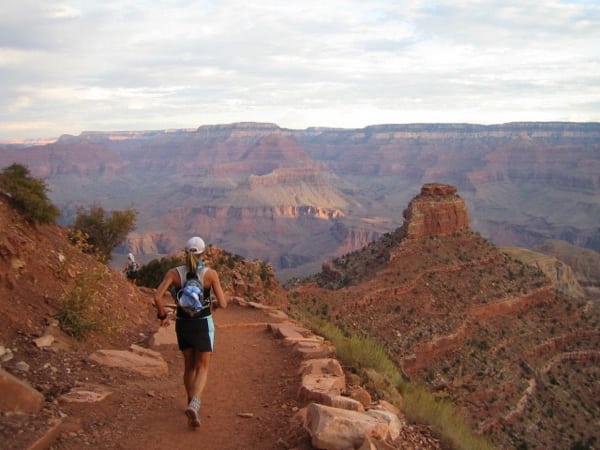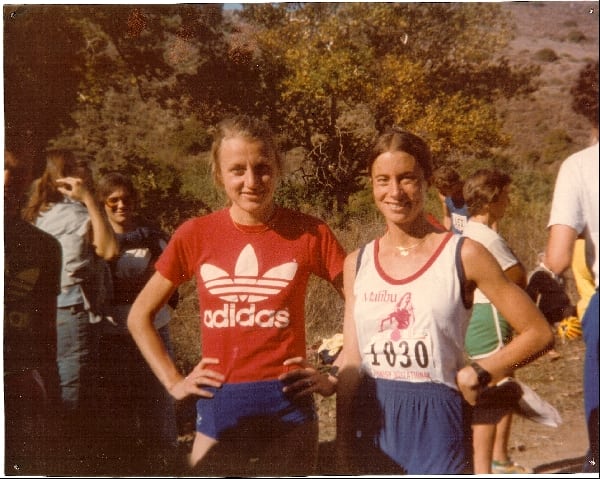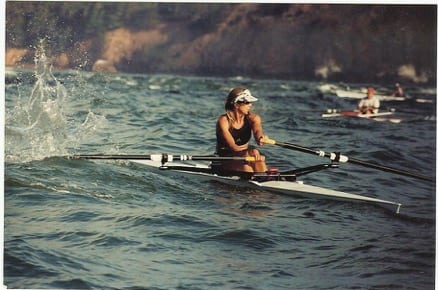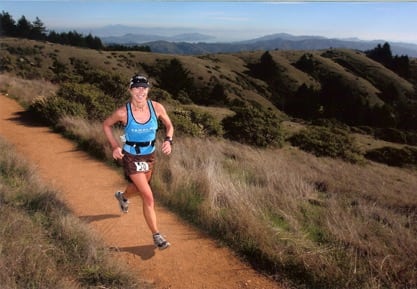For those obsessed with food, this story is for you.
When it comes to fueling for ultra distances–whether it is swimming, rowing, or running–there is a nutritionist who stands out amongst the rest. Sunny Blende is a renowned endurance-sports nutritionist who has gained such a reputation from a combination of her science-based methodologies, her long-term Ultrarunning Magazine nutrition column, and her personal experience living and fueling as an ultra athlete.
I could have spent all day asking Sunny questions. “What carbohydrates are best in a race?” “Should certain people abstain from dairy products?” “What is the real deal with cholesterol?” Like many, I just want to say: “Okay, tell me everything you know. I’ll do it, no questions asked.”
But it is not that simple and Sunny cannot be that easily played. “Many people just want a meal plan, ‘Just give me what to eat and I will eat it,’” she told me. “That is not teaching somebody. I want to teach people things because that is how it becomes a habit.” Nutrition is not taught by saying, “I am not going to eat sugar anymore,” she said. “It has to be a habit.”

Sunny running in the Grand Canyon. All photos courtesy of Sunny Blende.
Sunny, age 65, has a lifetime of personal experience in athletics, health, and food, which have molded her habits into a way of life from which she will never fully retire. Though she is now professionally retired, she calls it “semi-retired” because she cannot seem to break the “habit” of publishing articles, traveling the country to speak, and volunteering for organizations and at events.
She attended the University of Southern California for dental school, worked as a dental hygienist for 33 years, and then in 1996 went for a human-nutrition master’s degree from the University of New Haven in Connecticut.
“My hands began to give out,” she said. “Thirty-three years is along time to be a dental hygienist, not many people go that long.” Nutrition seemed like a natural path for her after that. “I was always fascinated by nutrition, partly because of being a dental hygienist,” she said. Most of her fellow nutrition graduates went into working for food companies, but Sunny wanted to be more in the health and sports industries. She decided to open her own sports-nutrition practice.

Sunny and Grete Waitz after the Lasse Viren Finnish Invitational in 1979.
Sunny expected that she would have masters-age clients who could afford a nutritionist and a trainer, but instead her main athletes have been in high school, college, and ultrarunners of all ages.
She also taught a class at College of Marin in Kentfield, California where she had a slew of students, all interested in sports nutrition for different reasons. “I had a lot of swimmers and runners in the class,” she said. “But I also had a lot of parents of those student athletes who had no idea what to feed their kids.”
Her program with students and non-athletes tended to center around the same structure. She started with basic nutrition–macro and micronutrients–for all-distance athletes–sprint, middle, and ultra–as well for team “start and stop” sports, such as volleyball and baseball. The main thing for everyone was the emphasis on real food and not relying on products made by sport-nutrition companies.

Sunny and the Badwater crew for Mike Sweeney in 2005.
When Sunny began writing for Ultrarunning Magazine in 2006, her career took off within the ultra world. Before then, there was not a lot of education available on fueling for a race longer than a marathon. “Marathon nutrition didn’t work great with ultras,” she said. “You can last two to four hours, but it is not great for 12 to 20 hours.”
Her ability to explain things in a way that everyone can understand, rather than in scientific terms, is something she prides herself in and is a skill for which many commend her. Tia Bodington, a previous iRunFar profilee, the Miwok 100k race director, and a former Ultrarunning Magazine editor, used to edit Sunny’s nutrition column at the magazine. “I was always amazed that she could take such complex topics and explain them in a way that the layperson could understand and implement,” Tia said.
Sunny said that, since she was running ultras by that time as well, she was able to start developing a program specifically for ultra distances based on how she herself felt. However, the biggest thing she has learned from the last 10 years of coaching is that there is no one way when it comes to nutrition. “There are actually many ways that work,” she explained. “You just need to work with the athlete and find out what works and what doesn’t. Some people can eat 24 gels in a 100-mile race and be fine with that. And I have had several runners throw up on me at mile 65 because they could not take another gel.”
It is through trial and error, she reminds everyone, that we navigate ultra nutrition. “I tell people to experiment and what I tell clients who are under-fueling–which is the usual problem since people don’t take in enough calories at the right time–in long training runs, eat till you throw up. Eat till you get sick!” she said. “They are like, ‘What?’” She then explains that perhaps he or she can eat more than they think, allowing them to get in more calories than they originally thought.
“Try something different,” she added. “Really, throwing up–in my definition–is erasing the blackboard and starting over.”
The goal is to get her athletes to think of fueling as a separate entity from eating. “It is not the same food we enjoy at dinnertime,” she said. Fueling, in Sunny’s terms, is something to help sports performance and something that can be sustainable down the road.

Rowing near the Golden Gate Bridge in California.
Over the years of training clients, watching races, and competing herself, Sunny realized the great deficit between the amount of calories we consume and expend during long bouts of endurance exercise. She began closely looking into how our body uses the fuel we put into it. By figuring out how to maximize the greatest number of calories, she stumbled upon the science of metabolic efficiency, or what is commonly referred to as fat burning.
“We all carry some fat no matter how lean we are,” Sunny said. “But how do we tap into it?” In a nutshell, Sunny trains her clients’ bodies to utilize stored fat, rather than just the instant carbohydrates we traditionally consume during exercise. It is a process, unique for every athlete, but one which offers an advantage to many kinds of athletes. She asked her clients to slow down for a period of eight to 10 weeks and told to lose the bad carbs. She hopes she shouldn’t have to say what those bad carbs are, she added.
Sunny says that the system only works with slow running, wherein the body doesn’t have to use many carbs due to the lack of the intensity. Sunny said that since she has begun working with the research, she has noticed more and more people catching on to the low-carb diet. This was especially spurred by the Paleo Diet trend since early 2000.

Sunny running and winning her age group at the 2010 The North Face Endurance Challenge 50k – San Francisco.
The Paleo diet, when revised years later, added in more carbs for athletes and reduced the amount of saturated fat, especially the bacon grease, she said. “Athletes weren’t competing well on just the Paleo Diet,” Sunny said. “My point on all diets is that all diets do have some good points to them, but use your common sense. As for a vegan diet, I have no problem with a vegan diet except that it is harder and you have to watch if you’re getting enough protein and iron.”
Sunny doesn’t tell people to cut out all carbs and run 20 slow miles a day. No, she makes suggestions like upping fruits, veggies, and protein, as well as switching up your regular pasta meal. “Instead of two thirds pasta and one third sauce and veggies, switch it up,” she said. “Do one third pasta and pile on the veggies!”
There is evidence from her everyday life. Fresh-caught fish from her lake-house property in Idaho and an entire head of asparagus, usually meant to feed five or six, split between her and her partner Randy Hixon. “We eat what is available and what is in season,” she explained. “And we use tons of different spices. We went to Morocco and fell in love with the spices, like turmeric and cumin.”
She only drinks water since juice, she claims, is barely a step above Coca-Cola. “Eat the orange and let your gut be the juicer,” she said. “Eat the food as close to the source as possible, like a carrot rather than carrot juice.”
“The only exception is carrot cake,” she added in, laughing. “That’s my favorite.”

Finishing an Alcatraz swim in the San Francisco Bay.
Another big issue in the diet are dairy products, yet Sunny says, once again, use common sense. “We need to choose dairy wisely,” she said. “Yogurt for instance. I have a big beef with the nonfat flavored yogurt because when you take the fat out, then they up the sugar you are putting in your body, which is inflammatory and spikes your insulin.”
Sugar. The ingredient every nutritionist and dental hygienist loathes to see. When switching over to more fat, protein, and real food during races for herself and her clients, the role of sugar in one’s health was another main factor she kept an eye on.
“Most athletes who are good in their sport don’t have a weight problem and don’t have to worry about eating a lot of carbs and gaining weight,” she said. “But if you ask me, it is the health as well. When you look at a long-term athlete, say 35 years long like me, exercising six or seven days a week for one to two hours a day and taking one to two gels a day, that is a lot of sugar I am putting into my body. And that is very inflammatory.”
Sunny doesn’t just teach these lessons. She tries to live them. Sunny has more than 30 years of single-scull rowing, years of distance swimming, mountain biking, hiking, and trail running. Add in paddleboarding too, another hobby she picked up about three years ago. Sunny is mostly a rower and runner. She grew up and still lives in southern California where she was a part of a very athletic family who traveled and hiked throughout the country.

Sunny gliding through Lake Tahoe during the Tahoe Rowing Regatta.
As a kid she watched the rowers glide along the bay outside her window and quickly picked up the sport, now having rowed all over the world with Randy, usually in single shells. The two, who are celebrating their 24th non-marital partnership this year, met during a rowing trip and since then, they have rowed to Catalina Island, California, a 32-mile row that takes about six hours to cross. They have also rowed across the Monterey Bay in California and through the Prince William Sound, Alaska–100 miles through glaciers. When the couple traveled to Budapest, Hungary and Australia, they rented boats as well.
If they haven’t rowed on a continent, then they have either hiked or ran on it. “I have been to every continent, even Antarctica,” she said. “I ran there, but there wasn’t an official marathon yet.”
Within the multitude of sports Sunny participated in while growing up, she stumbled across her love of running in 1972, when she was in her early twenties. In 1978, she completed her first marathon and several years after that she even discovered her love for trail running.
It was a decision she made by herself, to run a marathon. In a time of horrible, stormy weather at her home in southern California, Sunny had to drive to Santa Monica to buy roofing supplies to fix a damaged roof. While there and without telling anyone her plan, she parked her car, put a few dollars in her shorts pocket, and ran what she believed was a 20 miler, her longest run ever by 14 miles.

Running the Los Angeles Marathon in the early 1980s.
She ran through the town, along the ocean, and through the marina, asking the local sheriff for directions. She bought a Coke at a gas station and continued back toward her Volkswagen van.
“When I got back to the van I couldn’t step into it and I had to pull myself up by the wheel,” she said, laughing at the memory. “I limped into the store, got the roofing materials, drove home, and got into the bathtub, trying to move again. Then I told everyone I was going to train for a marathon and then went through the regular training.”
She had the opportunity to run international races, thanks to a friend who was on the Los Angeles Marathon committee. During one race, the Berlin Marathon, Sunny could only run for three hours, about 20 miles, and then she had to be on a train headed to Moscow, Russia for another appointment with her friend. “They had a cab waiting for me. It was pouring down rain so I was soaking wet and I was changing in the back of the cab and the cab driver was trying to watch me,” she laughed while retelling the story. “We barely made it in time, then they locked us in the cars. So, I didn’t get to cool down or stretch and didn’t get to eat for hours!”
It was back in the States, running a trail marathon in California, when the opportunity to step into the ultrarunning world presented itself.

Finishing the Skyline 50k.
Sunny won her age group and received a free entry into the Skyline 50k Endurance Run for her award. “I was like, “Oh my God, I won the prize, now I have to do it!” she exclaimed. “I really enjoyed it and I really liked trail running.”
She’s since completed numerous 50ks and 50 milers all over the country. She’s not run a 100 miler, but more adventure-type races and endeavors have taken her up and down a volcano in Maui, across the Grand Canyon’s Rim-to-Rim-to-Rim twice, and pacing at Western States and the Badwater 135 Mile.
I asked Sunny for her favorite race or destination and received a 10-minute answer with the inclusion of about seven different names. Her all-time favorite–she decided days after our initial interview–is the Run to the Sun in Maui, Hawaii, which is a 34-mile race from sea level to the Haleakalā summit at 10,000 feet. Her longest race was the 54-mile Mountain Masochist in Virginia, which she describes as a “no piece of cake” adventure.
Sunny has run the Dipsea Race, the oldest trail running event in the country, which takes place in California, many times. “I love the Dipsea Race,” she said. “I also love the Catalina Eco-Marathon, that’s a cool one. I think because I have rowed to and from the island in a race and have rowed around it. I know the water and I know the land and the buffalo and the wildlife. It is beautiful, there are no cars, and it takes you out of big-city life.”
She completed the Quad Dipsea in 2008, which is the seven-mile Dipsea Race route repeated a total of four times.

Racing the 2008 Quad Dipsea.
Other contenders include Badwater, at which Sunny has paced and crewed friends. One time at Badwater, in 2005, she crewed Mike Sweeney, who led for over 80 miles. “He would not get on the scale for the entire race and when we finally got him to we realized he had gained weight and was hypernatremic, so drinking too much water,” she said. “We brought him back around and focused on getting him up to Whitney Portal, so I took my top off and ran backwards so that he would have something to follow. He followed right up the mountain!”
Badwater holds a special place in Sunny’s heart because crews and pacers have to support their runner so much despite being sleep deprived and running in the over 100-degree Fahrenheit weather, she said. And, the beauty of the desert makes it one of her favorite races.

Pacing Luis Escobar along with Jenn Shelton and Billy Barnett at Badwater.
The “different” races, through the desert or before and after the kayak leg of an adventure race, are the types of activities Sunny enjoys.
The next big one for her is a three-day run through Bryce, Zion, and the Grand Canyon for the Grand Circle Trailfest this October. Despite now being in her “retirement,” Sunny will be attending the event to present on sports nutrition. It is a weekend she is beyond excited about, she said.
She also continues to work with long-distance swimmers. One, Paul Lundgren, will be attempting his fourth time across the Sea of Cortez, an 82-mile outing.
Her ability to drop and go to any volunteer, pacing, crewing, or teaching opportunity is an amazing attribute of Sunny’s, Tia added, who also mentioned Sunny’s continuous knack for taking on miscellaneous unsung tasks when Tia is directing the Miwok 100k. Sunny has the fun job of manning the Bridge View aid station. “Sunny is a dynamic, inspiring, and giving person who is not afraid to go after many of the amazing, athletic, travel, and volunteer opportunities this world has to offer,” Tia said, summing up her friend in one sentence.
Though Sunny is still hands deep in coaching, she did turn in her final nutrition column for Ultrarunning Magazine in January. “I will still write features and am still the nutrition columnist at Swimmer Magazine,” she said. “I stopped doing dental hygiene because my hands went out, but I loved it and still do and for sports nutrition. I think it is really nice to finish your career when you still really love something.”
Right now, Sunny and Randy have left their California home and relocated for the next few months at her parents’ old cabin in northern Idaho. There are bikes, fish, rowing shells, and trails. And lots of swim goggles, she added. Everything they need to live, until their next out-of-country trip.
Since toning down the workload, Sunny said she has been able to read her first fiction book in “I don’t know how many years.” Usually, she said, the books focus on science or the next trip she is planning.
In addition to the fiction novel, Sunny is nosing through books for her upcoming travel plans. Hiking and eating in France? Rowing and swimming in the Galapagos Islands? Running Italian trails before making her way to the beaches of Mexico and Costa Rica? She’s going to need some fuel for these adventures.
Call for Comments (from Meghan)
- What stories can you share about running and adventuring with Sunny Blende over the years?
- What nutrition advice have you learned from her via her longstanding Ultrarunning Magazine nutrition column?

Moving across the water in her latest sport love.
